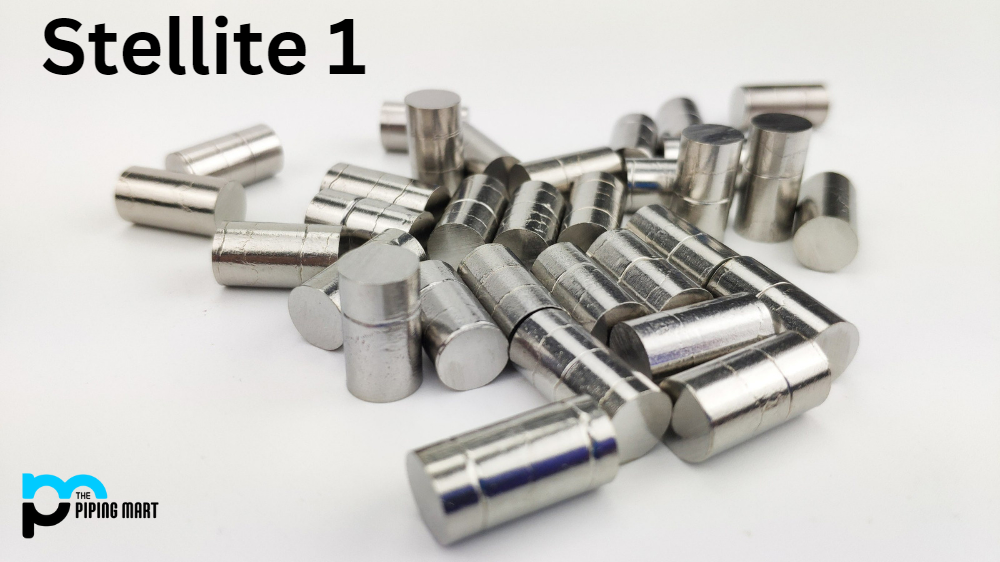The world of alloys is vast, and countless combinations have been discovered and developed. One such alloy is Stellite 1, known for its excellent physical and mechanical properties. It is a non-magnetic, corrosion-resistant, and hard-wearing alloy that finds its uses in various industrial applications. So, if you are curious to know more about Stellite 1, read on! This article will investigate its composition, physical and mechanical properties, uses, hardness, heat treatment, welding, and corrosion resistance.
Stellite 1 Composition
Stellite 1 is a cobalt-chromium-tungsten alloy that is reinforced with carbon and molybdenum. It usually has a composition of 30-33% cobalt, 12-15% chromium, 8-9.5% tungsten, 1-1.5% carbon, 1-2% silicon, and 1-1.5% manganese. The remaining percentage comprises iron, nickel, and other trace elements. This composition gives Stellite 1 its unique combination of physical and mechanical properties.
| Elements | Content |
|---|---|
| Cobalt, Co | 57% |
| Chromium, Cr | 28 – 32% |
| Tungsten, W | 11 – 13% |
| Carbon, C | 2 – 3 % |
| Silicon, Si | 1.20% |
| Iron, Fe | 1% |
| Nickel, Ni | 1% |
| Other | 1.50% |
Stellite 1 Physical Property
Stellite 1 exhibits an excellent combination of physical properties such as a high melting point (1410°C), low coefficient of thermal expansion, good thermal conductivity, and exceptional wear resistance. Additionally, it is non-magnetic and has good electrical conductivity, making it useful in electrical applications.
Stellite 1 Mechanical Properties
Stellite 1’s mechanical properties are equally remarkable. It has excellent strength, toughness, and hardness. Its hardness can reach 40-45 HRC (Rockwell C hardness scale), making it one of the most complex alloys commercially available. Moreover, it has good fatigue resistance, perfect for high-stress applications.
| Properties | Metric | Imperial |
|---|---|---|
| Density | 8.69 g/cm3 | 0.314 lb/in3 |
| Hardness, Rockwell C | 50-58 | 50-58 |
| Tensile strength | 1195 MPa | 173 ksi |
| Yield strength | 1050 MPa | 152 ksi |
| Modulus of elasticity | 230 GPa | 33.4×106 psi |
| Elongation at break | <1% | <1% |
Stellite 1 Uses
The unique properties of Stellite 1 make it perfect for various industrial applications. It is used in oil and gas industry applications exposed to corrosion, wear, and high temperatures. It finds its use in cutting tools, moulds, and dies. Additionally, it is used in surgical instruments, extrusion dies, saw teeth, and hot stamping dies.
Stellite 1 Hardness and Heat Treatment
As mentioned earlier, Stellite 1 is demanding and challenging to machine. However, heat treatment can relieve some of the stresses induced during machining and improve its mechanical properties. The heat treatment involves hardening the alloy by heating it to 1100-1150°C and then quenching it in water or oil. The resultant hardness can go up to 50-55 HRC, making it an even more durable and wear-resistant material.
Stellite 1 Welding
Welding of Stellite 1 is relatively challenging as it’s prone to cracking during the welding process. However, carefully selecting welding techniques and filler materials can help mitigate this issue. Tungsten inert gas (TIG) welding, plasma arc welding, and laser welding are commonly used welding techniques for Stellite 1. Moreover, filler materials such as nickel-chromium, nickel-chromium-boron, and nickel-molybdenum can be used to improve the weldability of the Stellite 1 alloy.
Stellite 1 Corrosion Resistance
Stellite 1 has excellent corrosion resistance properties, making it ideal for aggressive environments. Its resistance to both oxidizing and reducing environments makes it perfect for applications where the material is exposed to high temperatures and harsh chemicals.
Conclusion
In conclusion, Stellite 1 is a versatile alloy with excellent physical, mechanical, and corrosion properties. Its unique composition makes it perfect for various industrial applications, including cutting tools, moulds, dies, surgical instruments and extrusion dies. Its hardness, heat treatment, welding techniques, and corrosion resistance make it a reliable and durable material. So, if you’re looking for a material that can withstand high temperatures, corrosion, and wear, Stellite 1 is a perfect choice!




